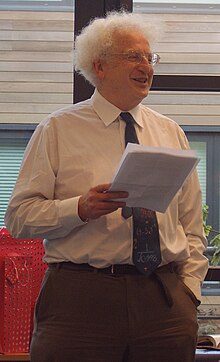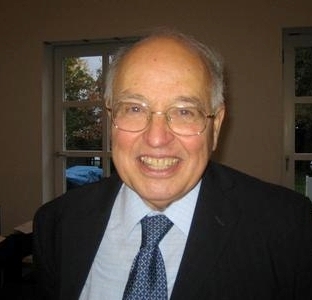
Sir Michael Francis Atiyah was a British-Lebanese mathematician specialising in geometry. His contributions include the Atiyah–Singer index theorem and co-founding topological K-theory. He was awarded the Fields Medal in 1966 and the Abel Prize in 2004.

Norman Earl Steenrod was an American mathematician most widely known for his contributions to the field of algebraic topology.
Donald Clayton Spencer was an American mathematician, known for work on deformation theory of structures arising in differential geometry, and on several complex variables from the point of view of partial differential equations. He was born in Boulder, Colorado, and educated at the University of Colorado and MIT.

Sir Erik Christopher Zeeman FRS, was a British mathematician, known for his work in geometric topology and singularity theory.
In mathematics, the cohomology operation concept became central to algebraic topology, particularly homotopy theory, from the 1950s onwards, in the shape of the simple definition that if F is a functor defining a cohomology theory, then a cohomology operation should be a natural transformation from F to itself. Throughout there have been two basic points:
- the operations can be studied by combinatorial means; and
- the effect of the operations is to yield an interesting bicommutant theory.
In mathematics, the tameness theorem states that every complete hyperbolic 3-manifold with finitely generated fundamental group is topologically tame, in other words homeomorphic to the interior of a compact 3-manifold.
David Gabai is an American mathematician and the Hughes-Rogers Professor of Mathematics at Princeton University. His research focuses on low-dimensional topology and hyperbolic geometry.

William Bernard Raymond Lickorish is a mathematician. He is emeritus professor of geometric topology in the Department of Pure Mathematics and Mathematical Statistics, University of Cambridge, and also an emeritus fellow of Pembroke College, Cambridge. His research interests include topology and knot theory. He was one of the discoverers of the HOMFLY polynomial invariant of links, and proved the Lickorish-Wallace theorem which states that all closed orientable 3-manifolds can be obtained by Dehn surgery on a link.

Vladimir Marković is a Professor of Mathematics at University of Oxford. He was previously the John D. MacArthur Professor at the California Institute of Technology (2013–2020) and Sadleirian Professor of Pure Mathematics at the University of Cambridge (2013–2014).
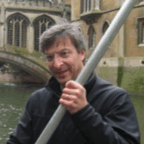
Charles L. Epstein is a Senior Research Scientist in the Center for Computational Mathematics at the Flatiron Institute. He is the Thomas A. Scott Professor of Mathematics Emeritus at the University of Pennsylvania, Philadelphia.
In hyperbolic geometry, the ending lamination theorem, originally conjectured by William Thurston, states that hyperbolic 3-manifolds with finitely generated fundamental groups are determined by their topology together with certain "end invariants", which are geodesic laminations on some surfaces in the boundary of the manifold.
The geometry and topology of three-manifolds is a set of widely circulated notes for a graduate course taught at Princeton University by William Thurston from 1978 to 1980 describing his work on 3-manifolds. They were written by Thurston, assisted by students William Floyd and Steven Kerchoff. The notes introduced several new ideas into geometric topology, including orbifolds, pleated manifolds, and train tracks.
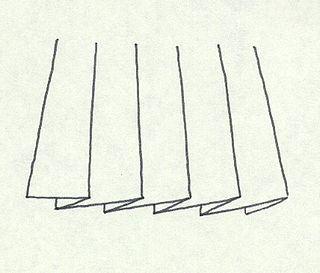
In geometry, a pleated surface is roughly a surface that may have simple folds but is not crumpled in more complicated ways. More precisely, a pleated surface is an isometry from a complete hyperbolic surface S to a hyperbolic 3-fold such that every point of S is in the interior of a geodesic that is mapped to a geodesic. They were introduced by Thurston, where they were called uncrumpled surfaces.
Igor Rivin is a Russian-Canadian mathematician, working in various fields of pure and applied mathematics, computer science, and materials science. He was the Regius Professor of Mathematics at the University of St. Andrews from 2015 to 2017, and was the chief research officer at Cryptos Fund until 2019. He was the principal of a couple of small hedge funds, and later did research for Edgestream LP, in addition to his academic work.
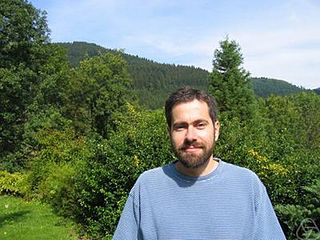
Yair Nathan Minsky is an Israeli-American mathematician whose research concerns three-dimensional topology, differential geometry, group theory and holomorphic dynamics. He is a professor at Yale University. He is known for having proved Thurston's ending lamination conjecture and as a student of curve complex geometry.
Paul Alexander SchweitzerSJ is an American mathematician specializing in differential topology, geometric topology, and algebraic topology.

Jeffrey Farlowe Brock is an American mathematician, working in low-dimensional geometry and topology. He is known for his contributions to the understanding of hyperbolic 3-manifolds and the geometry of Teichmüller spaces.
Edgar Henry Brown, Jr. was an American mathematician specializing in algebraic topology, and for many years a professor at Brandeis University.
Albert Marden is an American mathematician, specializing in complex analysis and hyperbolic geometry.

Alan William Reid is a Scottish-American mathematician working primarily with arithmetic hyperbolic 3-manifolds. He is the Edgar Odell Lovett Chair of mathematics at Rice University, 2017—present.
